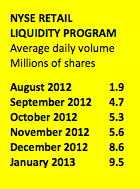The New York Stock Exchange’s program to get improved prices for retail investors from hidden institutional orders is ‘making headway,’ according to chief executive Duncan Niederauer.
The Retail Liquidity Program achieved average daily volume (ADV) of 9.5 million shares in trading conducted in January. That is five times the 1.9 million shares that traded daily in its first month last summer.
The program is “beginning to make headway with the expansion of participants and ADV growth, since the initiation of the program’’ on August 1, Niederauer told financial analysts recently.

The exchange said it did not have permission to disclose the names of the participants. But “several of our largest liquidity providers are involved with the program and we have seen their participation increase over time,’’ according to the exchange.
The program and variants introduced by the four major exchange operators represent a significant chance for the operators. By approving the programs, the Securities and Exchange Commission allowed them for the first time to give improved prices to one segment of customers and also to use subpenny pricing to achieve the goals. BATS Global Markets president and chief executive Joe Ratterman called this a “fundamental shift.’’
In the program, institutional investors, proprietary trading firms, algorithmic traders and other market participants place market or limit orders that offer improved prices to orders coming in from retail investors. Those orders are not be displayed publicly.

This is designed to help the exchanges compete with the matching of orders that takes place in brokers’ own pools of capital and other competing venues, where prices are not publicly displayed.
Before the launch of these programs, exchanges needed to give the same prices to “all customers, regardless of who they are, whereas non –exchanges have the ability to give better prices for particular customer groups,” NYSE executive vice president Joseph Mecane said. “This program allows an exchange for the first time the treat retail orders a little bit differently and potentially get better prices than they would at the public market place.”
The plans are designed to combat the matching of retail and institutional orders directly, inside brokers’ internal pools of orders.
In January, 2.4 billion shares a day, or 36.7% of all trading in equities, occurred in broker pools, dark pools and other off-exchange systems, according to data compiled by BATS Global Markets.
Nasdaq, in its plan, estimated the average price improvement would work out to 50 cents on a 500-share order.




